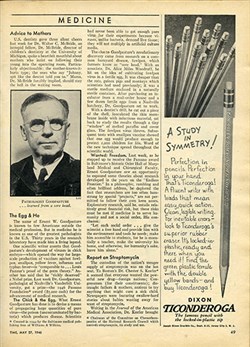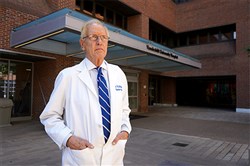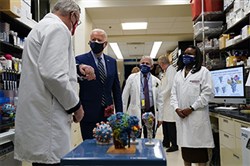VOL. 45 | NO. 23 | Friday, June 4, 2021
Conquer and prevail
By Kathy Carlson
Dr. William Schaffner still remembers the note left on his desk decades ago. In scrawled black marker it said: “I got it! B”
B was Dr. Barney Graham, a young internist at Vanderbilt University Medical Center. Graham had arrived in Nashville in 1979, fresh from the University of Kansas School of Medicine. These days, he guides a team of scientists at the National Institutes of Health that, along with others with Vanderbilt ties across the country, have helped the world understand and fight COVID-19.
Schaffner had come to Vanderbilt in 1962 after graduation from Cornell University Medical Center in New York. He stayed at Vanderbilt, became a professor of infectious diseases and has taught and mentored many physicians, including Graham.
Graham increasingly grew interested in infectious diseases at the start of his medical career, leading him to seek a research grant, Schaffner recalls. Graham, learning the grant was approved, rushed to Schaffner’s office only to find he wasn’t there. He jotted down a note and left it on Schaffner’s desk.
“It was so genuine, so simple,” Schaffner said. “…One of the great joys of being on a faculty (is) seeing the next generation flourish and expand science.”
The story of Vanderbilt scientists helping one another expand knowledge, especially about COVID-19, is one of cooperation, patience and eureka moments. Developing vaccines and medications wasn’t a straight shot from point A to point B or an overnight success. The successes of the past year were built on decades of research.
Vanderbilt scientists conducted clinical trials on COVID-19 vaccines and provided early, positive results on the Moderna vaccine’s ability to produce protective COVID-19 antibodies.
The scientists helped develop the antiviral drug remdesivir, which inhibits replication of the virus that causes COVID-19.
They discovered a combination of antibodies called AZD7442 that the pharmaceutical company AstraZeneca, under license from Vanderbilt, is developing and testing.
And they are now testing vaccines against emerging variants of SARS-CoV-2, as well as working on new treatments to prevent severe pulmonary and vascular effects of COVID-19.
Vanderbilt has a long history of interest in vaccines, say Schaffner and other scientists. It dates to the 1930s and Dr. Ernest W. Goodpasture. He grew up on a farm outside Clarksville, earned his undergraduate degree from Vanderbilt in 1908 and his medical degree from Johns Hopkins University in 1912.

Time magazine’s 1946 coverage of Dr. Ernest W. Goodpasture’s work growing viruses in fertilized chicken eggs.
Goodpasture returned to Vanderbilt in 1924 to head the department of pathology. He and his colleagues learned how to grow viruses in fertilized chicken eggs, making it possible to study viruses directly and leading the way to mass-produce vaccines against influenza, yellow fever and many other diseases.
Vanderbilt faculty members, researchers and students have continued to work over the years on vaccines against infectious diseases and also to study how vaccines fit into health policy and the prevention of diseases in whole populations, Schaffner explains. They examine the vaccine process in the lab, on the immune responses of animals and on humans in clinical trials. Then, after a vaccine has been licensed, Vanderbilt scientists investigate how well it works in real life, often on national evaluation committees.
The university received NIH funding for vaccine evaluation in 1974, through its pediatrics department. The fact that Vanderbilt didn’t have a freestanding children’s hospital until 2004, when the Monroe Carell Jr. Children’s Hospital at Vanderbilt opened, influenced Vanderbilt’s research culture.
It “actually led to more interaction with people in adult medicine and surgery because often they were cross-trained and had an active clinical role within the hospital because the pediatric group was so small,” says Dr. Peter Wright, currently a professor of pediatrics at Dartmouth Geisel School of Medicine in New Hampshire.

Dr. William Shaffner, was one of the national media’s go-to experts during the pandemic, helping the public understand COVID-19 and urging it to take proper precautions.
-- Photo By Michelle Morrow |The LedgerWright, who received his medical degree from Harvard in 1967, was recruited to Vanderbilt in 1974 to establish its first division of pediatric infectious diseases.
Dr. David Karzon, who had arrived at Vanderbilt from Buffalo, New York, six years earlier, recruited Wright. Even though there was not yet a separate children’s hospital, Karzon was building the team that would staff one in the future. He died in 2010 at the age of 90.
Karzon “was a wonderful mentor to me,” says Dr. Kathryn M. Edwards, Sarah H. Sell and Cornelius Vanderbilt Professor of Pediatrics at the Vanderbilt School of Medicine. Shortly after Edwards joined the Vanderbilt Vaccine Program in 1980, she applied for a short-term, $2,000 grant for pilot funding for a new program.
“David went over my grant. These were the days before word processing. … I think my first grant had more pencil (editing) than typed material,” she recalls. Then an assistant professor, Edwards was amazed that the chairman of the pediatrics department would take time over a weekend to meticulously edit the application.

President Joe Biden greets Barney Graham at the Viral Pathogenesis Laboratory. Dr. Anthony Fauci and immunologist Kizzmekia Corbett are at right.
-- Photo By Oliver Contreras/Sipa Usa)(Sipa Via Ap Images)“It showed the commitment he had to bringing his young people along. He expected a lot, (but he) made you feel you could do more, (that) I can do this better,” she adds. “It was all about science, not about you as a person. That sort of expectation for excellence is a driving force” for younger scientists.
Dr. Kathleen M. Neuzil is director of the Center for Vaccine Development and Global Health at the University of Maryland School of Medicine, where she also is a professor in vaccinology. She came to Vanderbilt in 1987 for a residency in internal medicine, followed by a fellowship in infectious diseases with Graham. She also earned a master’s degree in public health at Vanderbilt.
“I also just think I was sometimes in the presence of giants,” she notes. “… I was just really fortunate to be with a really incredible group of people” who ended up being leaders in the fight against COVID-19. She helped design the first COVID-19 clinical vaccine trial in the United States and is part of an NIH-funded team evaluating COVID vaccines and therapeutics.
“My mentors didn’t see me as competitive” (with them), Neuzil continues. “They saw that they could extend their work and impact if I was well-trained and (successful) myself.”
“We are all very good friends, relishing the success of one another,” Edwards says. Many physicians and researchers lived in the same neighborhood, and their children often attended the same schools and played on sports teams together.
“It was sort of a halcyon time,” Wright recalls, with “essentially no boundaries” between pediatrics and medicine.
“We had important grant support to do clinical trials,” he continues. That brought financial flexibility and people were encouraged to “follow their intuition and leanings about what was important.”
“We all very much enjoyed each others company, too,” he adds. “We liked each other.”
“There’s a social aspect of Nashville and the South that is different from other places where I have lived,” Neuzil says. Karzon, Wright and others, for example, “were very senior to me at the time (but) I knew their spouses and children.” She and other junior researchers joined in cookouts and other occasions that senior department members hosted for the whole department.
Edwards says medical colleagues at Vanderbilt have consistently collaborated over the years. “I think it was David’s leadership. It’s really about the quest for knowledge, not personal aggrandizement.”
Karzon also drew non-pediatrician physicians into pediatrics to work on infectious diseases, and Graham was among the first internists in the group. He remained at Vanderbilt for 22 years.
“It was a great place for a person like me,” Graham says. He became a fourth fellow in infectious diseases one year when there was dedicated funding for only three, thanks to a faculty member in another specialty who allowed some of his fellowship money to fund a fourth infectious disease fellow.
Graham didn’t study coronaviruses intensively until 2012. Before that, he had studied HIV and respiratory syncytial virus (RSV), which usually causes mild, cold-like symptoms but can kill vulnerable people, including infants and the elderly. A vaccine had been developed to prevent RSV in children, but it made some children much sicker. Early in his career at Vanderbilt, Graham wanted to understand how a vaccine could make children sicker, which led him to pursue the doctorate.
He says Dr. John Oates, who chaired Vanderbilt’s department of medicine from 1983 through 1997, supported him in pursuing the doctorate, even though he also taught on the medical school faculty. Graham earned his doctorate in 1991. Oates died in August 2019.
In studying RSV over the years, Graham and colleagues untangled the structure of the virus at a very specific instant in time, as it exists after it gets into the body but before it infects a cell.
RSV, like a coronavirus, uses proteins to fuse with and infect healthy cells. Conventional vaccines, including the RSV vaccine that made children sicker, use a version of the virus after it has fused and gotten inside a cell. The pre-fusion forms are unstable.
Graham’s group, along with Jason McLellan, now at the University of Texas, and Peter Kwong, head of the Structural Biology Section at the NIH’s Vaccine Research Center, learned how to stabilize the prefusion virus for use in a vaccine. The RSV vaccine that was developed is currently in Phase 3 clinical trials.
Graham’s group also learned that the process used to stabilize the prefusion RSV virus could be applied to similarly stabilize prefusion coronaviruses, because both they and RSV are enveloped within lipids and fuse with healthy cells. Other viruses are in protein shells and use a different means to infect the body.
With the 2002 emergence of SARS, the first animal-to-human coronavirus and a close cousin of the virus that causes COVID-19, scientific interest in coronaviruses increased. Some scientists were skeptical, however, because only three of the seven known human coronaviruses cause serious disease; the others cause the common cold.
Graham’s Vanderbilt colleague, friend and across-the-street neighbor, Dr. Mark Denison, had been studying coronaviruses since 1984 and is now one of the world’s foremost coronavirus experts. He came to Vanderbilt’s pediatric infectious diseases group in the 1990s and today is the Edward Claiborne Stahlman professor of pediatric physiology and cell metabolism and director of the division of pediatric and infectious diseases at VUMC.
His lab led the development of the COVID-19 antiviral treatment remdesivir, and he also was the first to show human antibody response to the Moderna vaccine, Vanderbilt Chancellor Daniel Diermeier said in a webinar late last year.
And when Graham began to actively work on coronaviruses at the NIH, he says, “I engaged Mark to help me.”
This spring, longtime colleagues Denison, Neuzil and Graham participated in a webinar on COVID-19 research, part of the Vanderbilt Chancellor’s Lecture Series. It was moderated by Vanderbilt Provost and Vice Chancellor for Academic Affairs Susan Wente, herself a medical researcher.
The scientists talked about the need for a long-term approach to scientific research and called for a commitment to fund basic research that’s based on long-term scientific and public health priorities.
“It takes some time to find your niche,” Graham points out. “… At Vanderbilt people would see something in you and have patience. That doesn’t necessarily happen at all places. … For me the lesson is, you need to not overlook the potential in people and let them do things without putting too many barriers in their way.”
It’s a little like how Graham didn’t allow the lack of a proper piece of paper to stop him from sharing his good news about grant funding with his professor, Schaffner. Graham looked around the office, pulled a piece of paper towel out of a dispenser on the wall and improvised.
“For reasons I cannot understand,” Schaffner said, “… I took that paper towel and stuck it in my file.” He still has it.